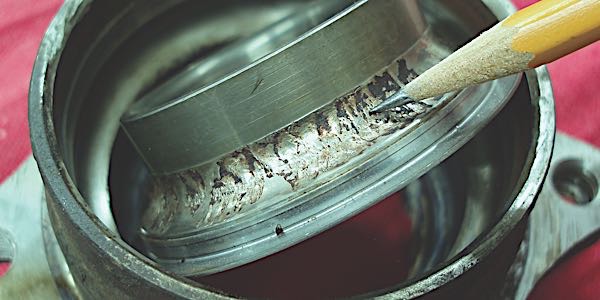How To Diagnose NVH Complaints In Drivetrain Components
Thanks to advanced technology, modern vehicles operate with fewer noise, vibration and harshness (NVH) complaints than ever before. Consequently, when a NVH issue arises, it’s most likely caused by worn drivetrain components like universal joints, constant velocity joints or wheel bearing hub assemblies. In any case, NVH complaints can often be the most challenging to diagnose when you can’t duplicate the driving conditions under which they occur.

Diagnosing And Repairing Worn Brake Hydraulics
During a service writer’s efforts to sell competitive brake services at the service desk, he or she often focuses on selling “good, better or best” brake friction replacements, while ignoring the added expense of repairing brake hydraulics. Unfortunately, neglected brake hydraulic systems can cause an expensive warranty comeback or, even worse, a serious traffic accident. In any case, it’s important to advise a potential customer of the importance of servicing and repairing worn brake hydraulics.
Tech Feature: Ignition Coil Diagnostics
Import Specialist Gary Goms says there are a variety of opinions about how to test ignition coils and ignition systems. The most basic method is measuring a coil’s primary and secondary resistance. If a coil doesn’t meet the manufacturer’s specifications, it should be considered defective. But meeting primary and secondary resistance specifications on the bench is no guarantee that the coil will perform correctly under extreme heat and load.
Winter Starting And Charging System Maintenance
In addition to checking the strength of the antifreeze, a cold-weather starting inspection should also include testing and visually inspecting the battery and cables, starter, alternator and changing to the auto manufacturer’s recommended engine oil. Because cold weather slows down the chemical reaction between its electrolyte and its battery plates, the average battery can lose more than 50% of its cranking amperage at 0 degree F. For that reason, cold-weather starting quickly separates OE-specification from non-OE-specification batteries.
8 Common Diagnostic Mistakes
Many diagnostic mistakes that become “diagnostic dilemmas” are caused by basic oversights or incorrect assumptions on the part of the technician. Research time and testing time have become the cornerstones of modern diagnostics.
PCM Diagnostics Case Study: No-Code Misfire Diagnosis On A 1998 Toyota 4Runner
When doing mobile diagnostic work for other shops, contributing writer Gary Goms usually sees more than his share of random no-code engine performance complaints. In the following case study, the customer of a client shop complained about an intermittent rough idle on his well-maintained 1998 Toyota 4Runner, but only when it was driven in hot weather. The client shop couldn’t duplicate the complaint, no matter how long the engine ran. Of course, the lack of DTCs didn’t help the diagnostic process.
Diagnostic Dilemmas: Solving Starter And Alternator Problems
The starter “solenoid” is actually a combination of an electric relay and solenoid. The relay portion electrically connects the starter armature to the battery. The solenoid portion mechanically engages the starter’s drive pinion with the engine’s flywheel gear.
Building Oil Change Profits One Job At A Time
Gary Goms defends the oil and filter change, but suggests introducing the term, “recommended maintenance interval,” and explains how shops can capitalize on profitable lubrication, drivetrain, filter, lighting, battery and tooling services in the process.
Diagnostic Solutions: Variable Camshaft Timing And Back Pressure Issues
When the topic of variable valve timing (VVT) comes up in import repair shops, few realize that the concept of increasing low- and high-speed engine torque by automatically advancing and retarding valve timing isn’t a recent development. For example, I recently discovered an old variable camshaft timing gear that I bought during the 1960s featuring a torsion spring device that retards valve timing in response to the increased rotating torque needed to turn the camshaft at higher engine speeds.
Diagnostic Dilemmas: Building A Plan For Diagnosing Electrical Problems
Every once in a while, I see the topic of a diagnostic check sheet come up on the International Automotive Technician’s Network (iATN) or other industry media. Most often, the question is asked by a shop owner or service writer who is trying to simplify his life by devising a “canned” step-by-step approach to solving various electronic diagnostic problems. Although a canned procedure is a good place to start, it’s not a sure-fire way to solving electronic problems.
Troubleshooting Mass Air Flow (MAF) Sensors
Troubleshooting mass air flow (MAF) sensor problems can become a major headache for import technicians because the failure is usually one that involves a calibration error rather than an outright electrical or mechanical failure. Because calibration errors tend to be “gray-area” types of problems, we will begin by looking at the basics of how a “hot-wire” MAF sensor measures airflow through an engine running at various speeds and loads.
Diagnostic Solutions: Engine Coolant Temperature Sensors
Considering that roughly 1,500 or more different vehicle models are introduced into our domestic market each year, it’s becoming more difficult to predict how a Powertrain Control Module (PCM) will utilize data from a particular sensor or detect an out-of-range sensor in any single vehicle platform. The engine coolant temperature (ECT) sensor provides a good illustration of how many on-board diagnostic strategies have changed.
